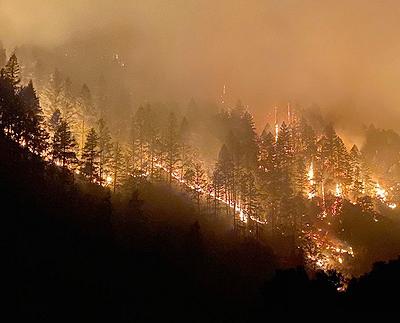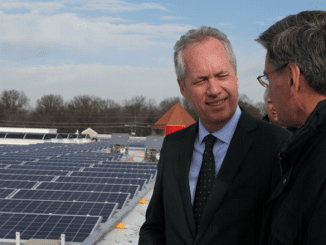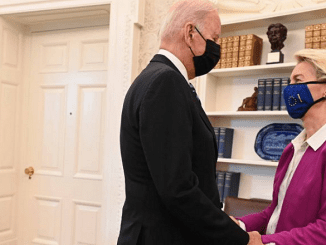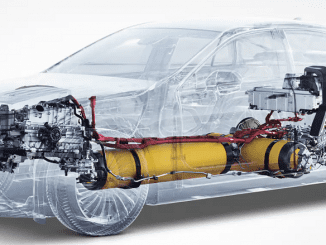
GOLDEN, Colorado, October 23, 2020 (ENS) – In rural Northern California, inland American Indian reservations risk being “islanded” from the larger electricity grid should a wildfire disable the single transmission line that delivers power to their homes, businesses, and critical services providers.
In Alaska, flooding and erosion pose imminent threats to 31 rural villages. Of these 31 communities, more than a third must relocate.`
In the Northeast, year-round residents of 15 island communities off the coast of Maine face electricity rates as high as four times the national average due to aging infrastructure, seasonal fluctuations in electricity demand, and lack of efficiencies of scale.
In the U.S. Virgin Islands, communities rely on imported fossil fuels to produce desalinated, drinkable water and meet more than 98 percent of their electricity needs. This heavy dependence on diesel and propane results in utility rates three times higher than the U.S. average and leaves the territory vulnerable to outages.
Although they face different challenges and risks posed by the unique sets of conditions in their individual regions, nearly all remote and islanded communities in the United States today are pursuing holistic, long-term strategies to bolster their energy supply.

Because of their geographic isolation, remote and islanded communities face unique energy and infrastructure challenges and are vulnerable to energy disruptions. Overcoming these challenges and reducing risk requires ramping up resilience, often with limited resources and capacity.
As a partner in a new initiative announced on October 15 and sponsored by the U.S. Department of Energy, DoE, the National Renewable Energy Laboratory, NREL, aims to provide resources and access to on-the-ground support for remote and islanded communities seeking to transform their energy systems and lower their vulnerability.
“Remote and islanded communities face some of the highest energy costs in the United States and are often most vulnerable to disruptions,” said Daniel Simmons, assistant secretary for the DoE’s Office of Energy Efficiency and Renewable Energy.
“By leveraging, refining, and building on the technical assets and resources of the Department of Energy, and working in partnership with these communities, we believe that this program can enable communities to plan for a more resilient future with more affordable energy,” Simmons said.
The project will utilize a framework developed by the DoE’s Energy Transitions Initiative, ETI, sharing the tools and technical assets of community-based organizations and those of DoE’s national laboratories to advance energy transitions.
The ETI partnership project will leverage NREL’s 10+ years of work building resilience in remote communities worldwide.
Along with NREL, three other national labs will be part of the new initiative – Pacific Northwest National Lab, the Lawrence Berkeley National Lab, and Sandia National Labs.
Three specialized offices of DoE will also be part of the project – the Office of Strategic Programs, the Water Power Technologies Office, and the Solar Energy Technologies Office.
The partnership project aims to combine energy sector experience with specialized local expertise to address energy challenges, build capacity, and accelerate the sharing of best practices and innovations.
NREL and its team have selected and are finalizing contracts with five community-based partner organizations, two of them in Alaska. This coalition will work alongside competitively selected communities to plan for, withstand, and recover from energy disruptions.
The Community Partner organizations are:
* – Coastal Studies Institute, an inter-university marine science research and education institute located on Roanoke Island, North Carolina.
* – Island Institute, based in Rockland, Maine, is program director for Maine’s $2 million Marine Economy Roadmap/Workforce Development Project.
* – Hawaii Natural Energy Institute, a research unit of the School of Ocean and Earth Science and Technology at the University of Hawaii Manoa, helps the state achieve its mandate for 100 percent renewable electricity, and carbon neutrality by 2045.
* – Alaska Center for Energy and Power, based at the University of Alaska Fairbanks develops energy systems for islanded, non-integrated electric grids.
* – Renewable Energy Alaska Project, based in Anchorage, is a non-profit organization that defines itself as clean energy experts, educators, thought leaders, and collaborative advocates.
In fall 2020, communities will be able to apply to participate in this multi-year collaborative effort to achieve their resilience goals.
In Alaska, that means nuclear power, research on methane hydrates and development of advanced microgrids.
On September 17, the DoE announced the re-opening of its Arctic Energy Office, located on the campus of the University of Alaska, Fairbanks. Established in 2001, it had failed to take off due to insufficient funding.
Senator Lisa Murkowski, an Alaska Republican who chairs the Senate Energy and Natural Resources Committee, pushed for re-establishment in the 2020 Energy and Water Appropriations Bill, which supported the “promotion of research, development, and deployment of electric power technology that is cost-effective.”
Currently, researchers are exploring applications of advanced nuclear energy, such as microreactors and small modular reactors, in the Arctic.
The nuclear emphasis is designed to ensure U.S. competitiveness in nuclear infrastructure in the Arctic to keep ahead of other Arctic powers.
Last year, Russia introduced its first floating nuclear power plant built to provide power to the 50,000 people inhabiting Pevek, a port town above the Arctic Circle.
Energy Secretary Dan Brouillette said, “The United States is an Arctic nation and the region continues to play an essential role in meeting our nation’s energy needs, as well as those of our friends and allies.”
“The United States is an Arctic nation because of Alaska, and the reestablishment of the Arctic Energy Office in Fairbanks will ensure greater collaboration between our state’s innovators and the Department of Energy’s cutting-edge researchers,” said Senator Murkowski.
The ETI partnership project network has pledged to provide “technology-neutral technical assistance that prioritizes local challenges, values, and goals.” The program will support at least three cohorts of communities, with an anticipated 12-18 month project commitment per community.
Copyright Environment News Service (ENS) 2020. All rights reserved.
© 2020, Environment News Service. All rights reserved. Content may be quoted only with proper attribution and a direct link to the original article. Full reproduction is prohibited.



